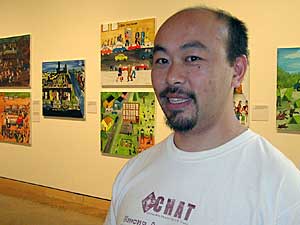| The Hmong in Minnesota |
Artist chronicles the Hmong migration
May 21, 2004
 |
| Artist Cy Thao stands next to "The Hmong Migration", his exhibit at the Minneapolis Institute of Arts. (MPR Photo/Laura McCallum) |
St. Paul, Minn. — "The Hmong Migration" is part history lesson, part art exhibit. Each of the 50 paintings is accompanied by a short description of a particular time in Hmong history. The paintings are full of vivid blues, greens, and oranges. Cy Thao said he chose the bright colors to make it easier to view paintings of war and genocide.
"The images and the stories are so depressing, so sad, that I think if I choose a different color, or a color that fits the story a little bit more, the tone of the story, I think, it would be too hard," Thao said.
 | |||
The story begins in China, where the Hmong people lived near present-day Beijing about 5,000 years ago. They fought against the Chinese, and lost, and many left the area. Over time, there were other wars, and some Hmong people migrated to Japan, others to Laos and other countries in southeast Asia. They helped the U.S. fight against communist soldiers, and after the Vietnam War, many fled to Thailand.
That's what happened to Thao's family. His father was a government official in Laos, and in 1975, he led his family of 11 across the river to Thailand in the middle of the night. Thao was 2 years old. His family lived in a refugee camp for about six years. One of Thao's favorite paintings in the exhibit is drawn from memories of living in the camp.
"There's a lot of waiting in the camps, and I essentially play that out with people waiting for water, and then they would wait for the truck, the U.N. truck that gives out ration; they ration out food, and it's a little bit more playful," he said. "You know, I was in the camp when I was two to eight. And so that was a time, where as a kid you don't worry about a lot of things."
The painting shows children playing in the middle of a refugee camp, in between lines of people waiting for food and water. Thao's paintings are two-dimensional, and the people he paints are almost cartoonish in their simplicity. Thao said he chose the childish style because of the graphic nature of some of the scenes. One shows Communist soldiers massacring Hmong villages, another shows two men being forced to dig their own graves before being shot.
 | |||
"That was about my two uncles, who, after the end of the war, they went to a different village to go get salt," Thao said. "And they came back, and the guy who was in charge, meaning the guy with the most gun in the village, accused them of being Communist. Because they went to a Communist village to get salt. And so they were ordered to march out into the field and dig up their own grave, and they were shot and buried there."
The last dozen paintings in the exhibit show the Hmong migration to the U.S., with all its struggles, such as finding jobs, learning English and fitting in in American schools. Thao's family experienced those challenges when they moved to the Twin Cities. They lived in Minneapolis and Brooklyn Center when Thao was growing up, and then Thao went to college at the University of Minnesota-Morris, where he studied political science and art.
"It sounds awkward to people, but I'm actually doing both... both things that I studied," he said.
Thao used to run the Center for Hmong Arts and Talent, but now considers himself a full-time artist, when he's not working as a part-time legislator. He began his Hmong Migration series before he was elected to the Legislature in 2002.
Thao spent five years painting the collection, and was awarded a Bush Artist Fellowship to travel to China, Laos and Thailand to do research for the exhibit. He submitted his work to the Minnesota Artists Exhibition Program, which selects exhibits for a gallery at the Minneapolis Institute of Arts.
 | |||
Minneapolis artist Doug Padilla served on the panel that chose Thao's work. Padilla said he was impressed by the breadth of the exhibit.
"I mean, how often do you get to see a body of work that has decided to take as its focus the entire history of a people? Not just written history, but the mythological history of a people," Padilla said. "So the scope of the work is enormous, and I think it's enormously important because the Hmong came here. And people don't know about them, they don't know what they've gone through."
Thao said he feels an obligation to tell the Hmong story, and to preserve it for generations. He has shown his exhibit in a parking lot on University Avenue in St. Paul, and at a couple of college art galleries. This is the first time a major art institution will display his work. The exhibit runs through July 11.
|
News Headlines
|
Related Subjects
|

